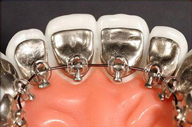Lingual Braces
 What Are Lingual Braces? Lingual braces are placed behind the teeth (by the tongue and palate), rather than in front, and therefore offer a great cosmetic alternative for those who want their teeth straightened, without the braces showing.
What Are Lingual Braces? Lingual braces are placed behind the teeth (by the tongue and palate), rather than in front, and therefore offer a great cosmetic alternative for those who want their teeth straightened, without the braces showing.
 The process for lingual braces involves taking an impression of the teeth, which is then sent to a dental laboratory and used to create customized brackets. The process takes about six weeks and, once complete, allows the orthodontist to use a specific process to cement the braces onto the back surfaces of your teeth.
The process for lingual braces involves taking an impression of the teeth, which is then sent to a dental laboratory and used to create customized brackets. The process takes about six weeks and, once complete, allows the orthodontist to use a specific process to cement the braces onto the back surfaces of your teeth.
Like traditional braces, this product works by applying gentle yet continuous pressure on the teeth, to help them slowly shift into proper position. The treatment can take anywhere from 18-36 months, depending on the severity of a patient's overcrowding of teeth or their bite. Braces are definitely worth the investment, but lingual braces have special requirements. Because they're custom made, they cost a bit more and treatment tends to be more involved. One of the biggest factors to consider is the cost of the materials; each tooth has its own installment of brackets and arch wires. Not all orthodontists offer lingual braces because training and technical expertise are needed.
 Taking Care of Lingual Braces As with any orthodontic appliance, good oral hygiene is essential to ensure that gingivitis or tooth decay don't creep in. Proper dental hygiene should include:
Taking Care of Lingual Braces As with any orthodontic appliance, good oral hygiene is essential to ensure that gingivitis or tooth decay don't creep in. Proper dental hygiene should include:
• Brushing twice a day for at least two minutes.
• Using a soft round-bristle toothbrush to brush at the gum line and the teeth.
• Flossing daily (floss threader can also be used) or an interproximal brush (if space between the teeth is present) to remove plaque and food debris between the teeth.
• Using an oral irrigation device to help flush out food debris around the brackets and teeth.
• Rinsing with a fluoride rinse to strengthen the teeth.
Lingual braces may also irritate the tongue and may cause it to become tender. Using wax against the lower teeth to cover the braces can help alleviate this soreness. Some people find speaking clearly and enunciating more difficult while wearing lingual braces. With enough practice, wearers get used to the feel of the braces on the backs of their teeth, and talking normally is a snap. Ultimately, professional dental cleanings every six months are critical to a patient's health with braces. Daily dental habits such as brushing twice a day and flossing daily will prevent plaque buildup and tooth decay, but using products like toothpaste can help keep gum disease at bay, and a fluoride rinse such provides added protection against tooth decay. Having a great smile is worth the temporary inconvenience and expense of braces. Some people are hesitant to invest in them despite the difference they can make — lingual braces are an answer to this problem. Whether you can see them or not, find out which braces are right for you. After all, a beautiful smile with healthy, straight teeth is absolutely worth the effort!

Orthodontics
- What are lingual or invisible braces ?!
- Gnathology
- Early Orthodontic Treatment: Braces for Young Kids
- Impacted Tooth
- Self-Ligating Appliance System
- Metal Or Traditional Braces
- Types of Braces
- Mini-Implants Or Mini-Screws For Orthodontics
- What Is Orthodontics?
- Lingual Braces
- EON Aligner
- Ceramic Braces